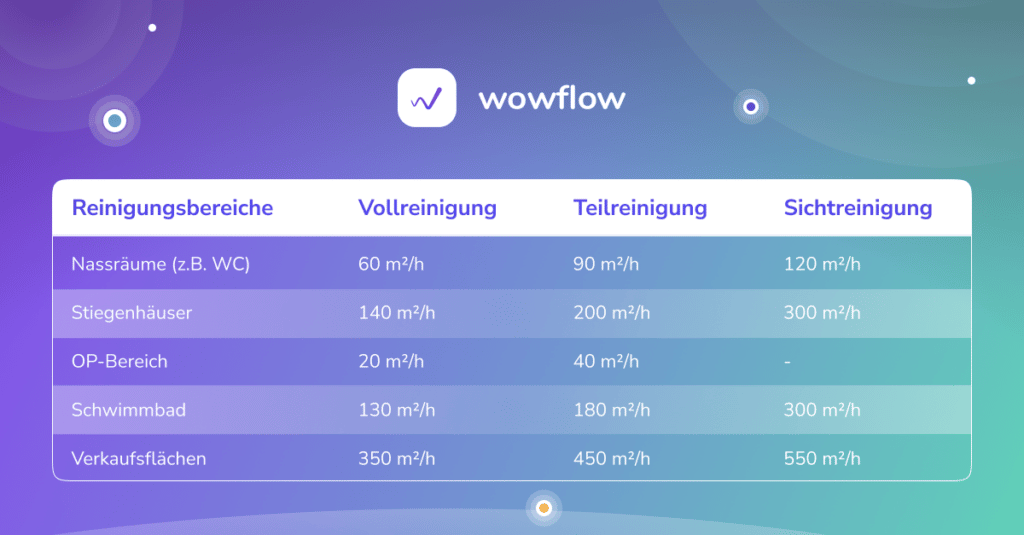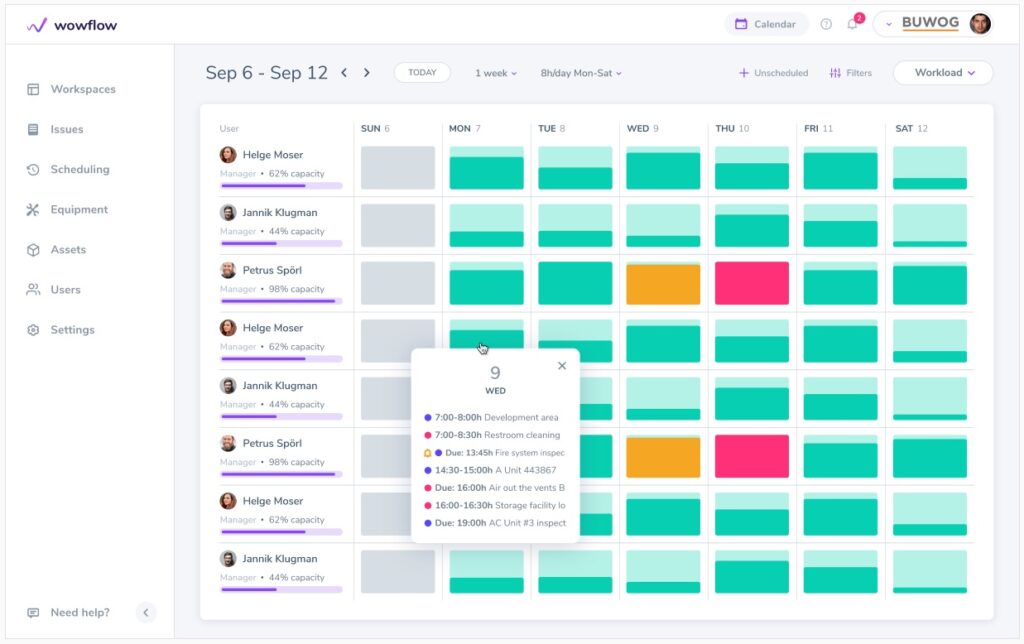These three key figures will help you run your cleaning company more successfully
Having already dealt with the seven most important key figures for facility management, it is now time to do the same for cleaning companies and facility services. This article shows you five important KPIs that relate to the personnel, economic and legal aspects of your company. We also explain the problems associated with non-compliance with key figures and how you can avoid them.
1. Legal key figures: Key performance indicators in the cleaning industry
Let’s start with the legal issues: Section 17 of the collective agreement for monument, façade and building cleaners regulates the key figures for cleaning services depending on cleaning levels, room areas and room use. The performance indicator refers to the m² that may be cleaned by the employee per hour. As already mentioned in the title of the paragraph, a distinction is made between the type of room being cleaned (e.g. a hotel room or an operating theater) and the type of cleaning that takes place there: Full cleaning, partial cleaning or visual cleaning. There are also other separately regulated forms of cleaning, such as general cleaning or large area cleaning.
Example: Performance values for maintenance cleaning (in m2/h):

Why are there performance indicators?
First and foremost, these indicators serve to protect employees. They should be protected from revision. On the other hand, employers – i.e. the cleaning companies themselves – also benefit from the key performance indicators. This is because it gives a clear indication of the size of the area to be cleaned. This results in a simplified offer and pricing structure: the basis is set by the legislator itself. In addition, wage and social dumping, i.e. underpayment in accordance with the law, regulation or collective agreement, can be prevented in this way – at least up to a certain point. The competitiveness of all market participants remains intact. And by the way, you should really stick to it, because: Wage and social dumping is a punishable offense!
A relatively recent example: An Austrian company – set up during the coronavirus crisis to supply Austria with FFP2 masks – apparently exploited several employees. The Chamber of Labor is concerned that something similar could now happen to refugees from Ukraine. The cleaning industry in particular is predestined for this. And not to forget: The managing director is personally liable in such cases!
2. Economic key figures for cleaning companies: Registered hours to sold hours & long-term cooperation with customers
An important economic indicator is the number of hours registered in relation to the number of hours sold. A brief example: The cleaning company “XY” employs Ms. Maier for 20 hours a week. However, due to the order situation, Ms. Maier can only actually work 16 hours. Although four hours must be paid out to the worker as wages, they are not recovered from the customer. This idle time means a loss for the company. You should prevent it at all costs.

The motto here is: Successful management through efficient deployment and personnel planning!
Long-term cooperation with your customers also plays a key role in the success of your commercial cleaning company. Or, above all, the long-term nature with which an employee works for a customer. Why is that the case? If your employees are already familiar with a building or area, there is no need for an initial inspection. Cleaning staff don’t have to find their way around first, they know their way around straight away. Vacation replacements are also often organized by the employees themselves because they know the property and value their workplace. This means: time saved, money saved. And that’s not all: long-term customers are usually satisfied customers. At best, they will recommend your service to others and become important references. This in turn leads to potential orders from new customers, but also to follow-up orders from existing customers – often without the need to search through tenders.
But be careful: Don’t let your clients poach your specialist staff! This can happen during a long-term collaboration. You should therefore pay attention to the content of your contracts.
3. Key personnel figures for building cleaners: employee absences & fluctuation
It goes without saying that the personnel figures go hand in hand with the economic figures. The issue of staff absences in particular has become a hot topic due to the coronavirus pandemic. Of course, “normal” sick leave and vacation-related absences are also included in this category. The aim is to keep downtime to a minimum and to be as well prepared as possible for this eventuality. The problem with absences is the fact that two specialists then have to be paid: The one on sick leave or vacation and the replacement. In addition, the replacement person may first have to be trained if they are not part of the existing team. In times of a pandemic and therefore unpredictable – and above all numerous – outages, this key figure takes on a special significance. If possible, it should be kept to a minimum.
The second key personnel figure: fluctuation. We can say straight away that every new team member who has to be trained costs time and money. Both are valuable assets, especially in the day-to-day business of a cleaning company.
The knowledge you already have in your company is valuable. Try to keep it!
Low employee turnover means less training effort. This is because the training of a new cleaning specialist is often accompanied by teething problems. What does low fluctuation usually mean? A high level of employee satisfaction. And satisfied employees have fewer absences (this has been scientifically proven!) – so there is a direct correlation with the first personnel indicator.
And what leads to a satisfied team? Many things. But these points are the cornerstones of your specialists’ satisfaction:
- Everyone has enough time for the work (hence the performance indicators at the beginning).
- Punctual and fair payroll accounting.
- Sufficient appreciation in the workplace.
- Open internal communication.
- If a tool is used, it should be multilingual and thus ensure inclusion.
Communication in the workplace therefore plays a particularly important role. If the customer is able to communicate the problem clearly and unambiguously, the cleaner will receive it in the same way – without “losses”. Think of it like the game “Silent Mail”. This is how it would work if there were no communication tools: The client says “remove”, but the cleaning staff say “declutter”. The garden furniture from the cellar may then be thrown away instead of being removed from one place and stored in another.
Key figures in commercial cleaning: The summary
The key figures at a glance:
- Key performance indicators
- Hours registered to hours sold
- Long-term cooperation
- Fluctuation
- Employee absences
These are the five most important key figures for the success of your cleaning company or facility service company. Achieving and improving the defined key figures does not happen overnight. This is an ongoing – and never-ending – process. As many processes in the company as possible should be automated. A tool that provides automation is particularly helpful when communicating with employees, coordinating and documenting work.
Wowflow is tailored to the needs and processes of cleaning companies. It helps to make process organization more efficient and thus saves money, time AND nerves. QR codes can be used to communicate clearly and quickly. Customers’ wishes and preferences are stored in the app at all times and can also be accessed by the vacation replacement. Unnecessary complaints are avoided.
These are just a few examples of how Wowflow works. If you would like to find out more, please contact us or take a look at our blog. Our next topic: How do I calculate the right hourly rate for my commercial cleaning company?



